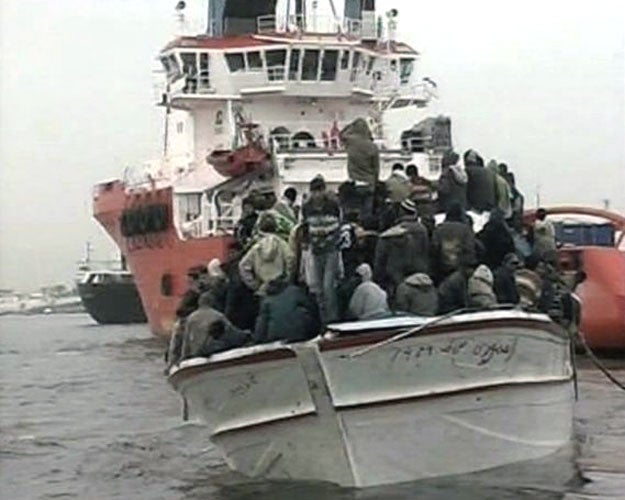Hundreds feared dead as migrant boats sink off Libya
Vessel built for 75 passengers was carrying 365 desperate refugees

More than 300 Africans seeking a better life in Europe are believed to have drowned in waters off Libya in one of the worst refugee disasters of recent years.
According to Libyan officials, four overcrowded boats departed from the coast near Tripoli over the weekend, bound for Italy. One of the rickety vessels was built to carry 75 passengers but was carrying 365.
The route from Libya to Lampedusa, Italy's southernmost island midway between Sicily and the north African coast, has become one of the most popular routes in the world for people-smugglers, who have made huge fortunes from a trade which has taken untold thousands of lives.
The three boats that set sail on Saturday and Sunday are believed to have run into fierce sandstorms known as ghibli 30 miles from Libya and capsized. Libya's most authoritative daily paper, Oea, quoted officials as saying that coastguards had recovered the bodies of 23 drowned migrants near the village of Sidi Belal, close to the wreckage of the three vessels.
"After more than two days of searching, we have found no more bodies or survivors," said a Libyan official. Although the majority of migrants who try to reach Italy from Africa depart from Libya, it is unusual for officials there to comment on the trade, which is centred on the boom town of Zuwara.
Another official quoted a Tunisian survivor of the wreck as saying: "I was on board the boat with 13 other Tunisians among the 365 migrants. I'm the only survivor [among the 13]. All my fellow Tunisians drowned." The other nationalities on board the boat included Somalis, Nigerians, Eritreans, Syrian Kurds, Algerians, Moroccans and Palestinians.
"There's no safety equipment on these boats," said Jean-Philippe Chauzy, a spokesman for the International Organisation for Migration. "No buoys, dinghies or anything, because the purpose is to cram in as many people as possible with total disrespect for their safety and dignity."
A fourth ship also got into difficulties, near Libya's Buri offshore oilfield. But the coastguard succeeded in towing it into Tripoli harbour.
Antonio Guterres, the UN High Commissioner for Refugees, said the disaster was "the latest tragic example of a global phenomenon in which desperate people take desperate measures to escape conflict, persecution and poverty in search of a better life."
The UN refugee agency, UNHCR, said the drownings marked the beginning of the "smuggling season". Although hundreds of migrants are thought to have perished on the dangerous voyage, more than 500 arrived safely in Sicily over the weekend. The latest catastrophe comes less than two months before a joint plan by Italy and Libya to combat the people-smugglers is finally supposed to come into operation. Italy has for years been trying to persuade Libya to accept the idea of joint naval patrols along its coast.
Rome is confident that the last wrinkles have been ironed out following a meeting in March between the Prime Minister Silvio Berlusconi and the Libyan dictator Muammar Gaddafi where Italy agreed to pay reparations for destruction wrought under Mussolini. The Italian Interior Minister Roberto Maroni – a leader of the Northern League, the most outspoken anti-immigrant party in Italy – said he expected the patrols to begin by 15 May.
The surge of boats setting out from Libya may reflect the determination of the people-smugglers to take money from as many of the 1.5 million Africans believed to be waiting for passage to Europe as possible, before the naval clampdown gets under way.
The migrant tide
Where do the migrants come from?
Most come from west African countries like Senegal, Mali, Burkina Faso, Ghana, Niger, Nigeria and Ivory Coast. Families will often sell their valuable possessions to send their brightest child to Europe. The people traffickers' fee can be as much as €2,000 (£1,800).
Why is the Libyan route in focus?
Stricter patrols in the western Atlantic by Spanish authorities have been relatively successful in slowing the flow of illegal immigrants to the Canary Islands, once the destination of choice. Libya's borders are still very porous, and the sea voyage much shorter.
What is the burden on Italy?
According to the UN, about 36,000 people crossed from north Africa to Italy last year, with the majority landing on the island of Lampedusa. About 75 per cent applied for asylum and half of those received some form of protection from Italian authorities.
Subscribe to Independent Premium to bookmark this article
Want to bookmark your favourite articles and stories to read or reference later? Start your Independent Premium subscription today.

Join our commenting forum
Join thought-provoking conversations, follow other Independent readers and see their replies